Funaria hygrometrica
Funaria hygrometrica Hedw
Family: Funariaceae
Common names: Common cord-moss, little goldilocks, golden maidenhair
Introduction
The attractive red-brown spore-bearing part of the plant (sporophyte), which consists of a long, twisting stalk (seta) with an asymmetrical, grooved capsule at the tip, makes Funaria hygrometrica easy to find and identify.
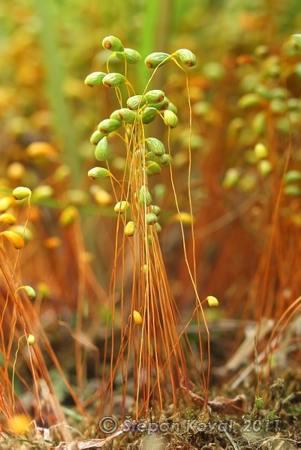
Description
Description
Funaria hygrometrica is rather inconspicuous when sterile (when the more conspicuous sporophyte has not yet developed). The obovate leaves form a bulb-like cluster at the top of the shortish, 3-8 mm long stem. The leaves are 2-4 mm long with an acute apex and weakly serrate margins. The midrib ends just below, or extends just beyond the leaf apex. The leaf cells are inflated, subhexagonal (± six-angular) to short-rectangular, somewhat narrower at the margin and oblong in the base. The colourful sporophyte is much longer than the stem from which it arises. The yellowish stalk (seta) that bears the capsule is 20-50 mm long. The distinctive capsule is horizontal to pendent, up to 3 mm long, reddish brown, asymmetrical, curved, more or less pear-shaped with an oblique mouth, with deep longitudinal furrows when dry. The teeth at the capsule mouth are arranged in two rows, with the outer teeth S-shaped and fused at the apex by a lattice disk. The cells of the capsule lid are twisted counter-clockwise. The inflated, hood-shaped calyptra is often seen covering the immature capsules. The spores are yellow-brown and very small.
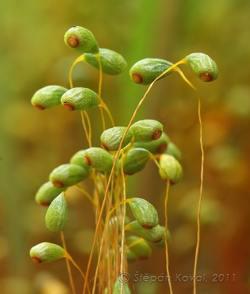
Conservation Status
Status
Funaria hygrometrica is widespread, common, frequently collected, and sometimes considered a weed, therefore not threatened.
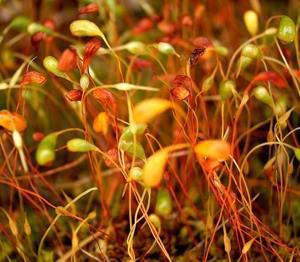
Distribution and habitat
Distribution description
Funaria hygrometrica is almost cosmopolitan in distribution. It is the most widespread and frequently collected species of Funaria in southern Africa and is known from Namibia, Swaziland, Lesotho and all nine provinces of South Africa.
It is found in a wide variety of disturbed habitats such as moist crevices in soil, walls or paving, next to water taps, gutters and drains, on soil in flower boxes and plant pots. It is often found in nurseries and hothouses. In southern Africa it occurs at altitudes of 20-2550 m.
Derivation of name and historical aspects
History
The name Funaria is derived from the Latin word 'funis' which means a rope. Species in this genus are known as cord-mosses because of the rope-like way in which the stalk twists and curls with changes in humidity. The specific epithet 'hygrometrica ' refers to the hygroscopic nature of the seta. The English names 'little goldilocks' and 'golden maidenhair' refer to the hair-like appearance of the densely packed, yellowish to reddish brown sporophytes.
Funaria is the largest genus in the moss family Funariaceae with about 80 species worldwide. Ten species are currently recognized in southern Africa, of which F. hygrometrica is the most widespread and frequently collected. The asymmetrical, curved capsule, deeply grooved when dry, with its large, oblique mouth and spirally twisted cells of the lid, is characteristic of Funaria hygrometrica.
Ecology
Ecology
Funaria hygrometrica is nitrophilous (nitrogen-loving) and frequently occurs around human dwellings and dairies, where it grows in moist crevices of walls, paving and the sides of water troughs. It has a distinct preference for recently burnt sites where it colonizes the nutrient-poor top layer of the soil. The species completes its life cycle quickly before weathering (mechanical and chemical breakdown of the habitat), microbes and other plants make the habitat unsuitable. Its presence may also indicate the site of an old camp fire, fire pit or human dwelling.
Uses
Use
In nurseries and greenhouses, where Funaria hygrometrica flourishes in the wet, disturbed conditions, it is sometimes regarded as a weed. This species is widely used in textbooks and biology classes to demonstrate the life cycle of a typical moss (the alternation of two generations: the plant body or gametophyte bearing sexual organs which develop into the spore-bearing sporophyte), possibly because of the abundant, conspicuous sporophytes and its frequent presence in greenhouses.
In countries of the northern hemisphere, mosses are commonly used in container gardens with bonsai and bonkei. In such gardens Funaria hygrometrica will provide ‘vegetation' of intermediate size, for example between 'mountains' of Leucobryum and ‘grass' of Physcomitrium or Bryum argenteum. It can also be grown in terraria under more moist conditions.
Growing Funaria hygrometrica
Grow
Apparently Funaria hygrometrica is easy to grow from ripe spores, which can be ‘sown' on a growing medium like Knop-agar, or on wet soil.
References
- Atherton, I., Bosanquet, S. & Lawley, M. (eds). 2010. Mosses and liverworts of Britain and Ireland - a field guide. British Bryological Society.
- Glime, J.M. 2007. Bryophyte ecology . Volume 1. Physiological ecology. Ebook sponsored by Michigan Technological University and the International Association of Bryologists. accessed on 16 August 2013 at <http://www.bryoecol.mtu.edu/> .
- Glime, J.M. 2007. Bryophyte ecology . Volume 5. Uses. Ebook sponsored by Michigan Technological University and the International Association of Bryologists. accessed on 19 August 2013 at <http://www.bryoecol.mtu.edu/> .
- Magill, R.E. 1981. Flora of southern Africa . Bryophyta. Part 1 Mosses. Fasc. 1 Sphagnaceae-Grimmiaceae. Botanical Research Institute, Department of Agriculture & Fisheries, Pretoria.
- Van Rooy, J. 2001. Introduction to bryology in southern Africa. 10. Eleven mosses to know. PlantLife 25: 37-40.
Credits
Jacques van Rooy
National Herbarium/ Biosystematics Research & Biodiversity Collection
September 2013
Plant Attributes:
Plant Type: Moss
SA Distribution: Eastern Cape, Free State, Gauteng, KwaZulu-Natal, Limpopo, Mpumalanga, North West, Northern Cape, Western Cape
Soil type:
Flowering season:
PH:
Flower colour:
Aspect: Shade, Morning Sun (Semi Shade), Afternoon Sun (Semi Shade)
Gardening skill: Challenging
Special Features:
Horticultural zones











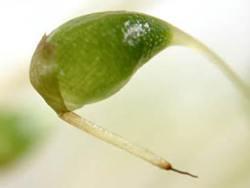
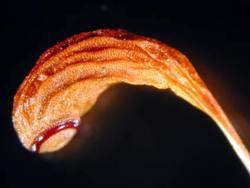
Rate this article
Article well written and informative
Rate this plant
Is this an interesting plant?
Login to add your Comment
Back to topNot registered yet? Click here to register.